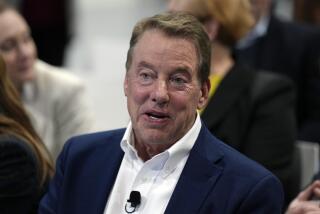Donald E. Petersen Retiring as Ford Chairman
- Share via
Ford Motor Co. Chairman Donald E. Petersen--who engineered much of the auto maker’s dramatic turnaround in recent years and its adoption of sleek, aerodynamic styling--said on Friday that he will retire March 1 and be replaced by Vice Chairman Harold A. Poling.
The nation’s No. 2 auto maker is not expected to make any dramatic changes as a result of Petersen’s departure, say analysts, who had expected the highly regarded, 63-year-old chairman to remain on the job for at least one more year.
“We don’t expect a big shake-up at Ford when this happens,” said Cynthia Certo, an analyst at Integrated Automotive Resources, a marketing research firm. “Petersen is really leaving with everything in pretty good shape.”
At a news conference at Ford headquarters in Dearborn, Mich., Petersen, who was named chairman in 1985, said he wanted to devote more time to his family and perhaps involve himself in education issues.
“I will have been chief operating officer or chief executive officer for 10 years,” said Petersen, “and I think it’s time for me to make a change in my life.”
Petersen’s upcoming departure and other top-level mangement changes will leave Ford with an orderly succession, say analysts. Poling, 64, who is recognized for his financial skills and knowledge of Ford’s foreign operations, says he plans to retire within three years.
Many Ford observers considered Ford executive Allan D. Gilmour, 55, as Petersen’s heir apparent. But Gilmour was promoted to president of the Ford Automotive Group and is expected to become chairman after Poling, who is also chief operating officer.
Philip E. Benton Jr., 60, currently president of the Automotive Group, will become Ford president and chief operating officer. The title of president had been dropped in 1987 when Poling became vice chairman.
Petersen will leave Ford after a decade that saw the company rise from near bankruptcy to record profitability. During Petersen’s first year as president in 1980, Ford reported a $1.54-billion loss.
An engineer by training who attended high-performance racing schools, Petersen began to turn things around by emphasizing quality auto production. He also dramatically cut costs and closed under-used factories.
Petersen’s love of high-performance cars and sporty design resulted in the introduction in 1985 of the Ford Taurus and Mercury Sable, whose aerodynamic design set the cars apart from look-alike competitors, and redesigned versions of the Thunderbird and Mercury Cougar.
By 1988, Ford eclipsed General Motors as the country’s most profitable auto company, with earnings of $5.3 billion.
“Ford’s performance over the past decade has been nothing less than outstanding,” said Ronald Glantz, an analyst at Montgomery Securities. “Petersen has left Ford better prepared than any chairman in generations.”
Still, some of Petersen’s strategies have yet to be tested, including last month’s deal to buy Jaguar of Great Britain for $2.5 billion and the firm’s effort to redesign and build the Tempo and Escort from various worldwide sources.
Analysts say Poling, Petersen’s successor, will have his hands full. Domestic sales are expected to remain weak during 1990, and the Japanese are planning to open more new factories in the U.S. and Canada--compounding the industry’s overcapacity problems. Meanwhile, the government is expected to press for tougher antipollution and gasoline consumption regulations, which auto makers claim will be costly to implement.
Poling’s three years “will hardly fly by,” said analyst Arthur G. Davis at Prescott, Ball & Turben Inc. “Three years in the auto business has the ability to seem like an eternity.”






